Hallo!
No, not the finishes found on original revolvers leaving the factory.. but rather the antique or relic condition finishes found on original surviving Period firearms.
“Antique Finish. “The worst looking and most unauthentic and unhistorical guns one can buy.
In some segments of the reenacting and e3ven living history community, there used to be (and still is sometimes) the notion that using an original was the ultimate form of authenticity and historical correctness. Why? Because what can be more authentic and more Period Correct than to use the actual weapons used in the Civil War? Especially when the alternatives NUG fall to using Italian reproductions that while close simulations are not exacting copies or actual reproductions.
The flaw or farbery in that line of thinking is that yes, it would be true, if we all had the money to seek out and find original weapons in the condition they were when they were actually in use during the Civil War RATHER THAN 150 year old antiques or relics used, worn, battered, beat, faded, rusted, scratched, gouged, worm eaten, missing parts, sanded, polished bright, etc.
Instead, due to availability and particularly cost, what most lads do who use (unrestored) originals do, is to use a gun that is a century and a half too “relic condition” to have a believable image.
For the mounted service, this gets complicated by the availability of “antique finish” revolvers.
In Reenacting History, this generally grew out of lads building kits and lacking the access or ability to replicate color case hardening and blueing so they left things “in the white” or had revolvers so worn and beat that their finishes were shot and they wanted to make them more “original” looking. NOT as originals when in use, but as the antique, relic, and otherwise “distressed” look many older lads grew up watching in movies or in 1950’s or 1960’s TV shows before they arrival of Italian prop firearms that have largely replaced the old worn and beat bare metal originals used over and over and over until many believe that to be how firearms actually looked back then.
The history of antique finish revolvers can be traced back to the late 1990’s when Cimarron Firearms Company had an idea to appeal to original military and western leather collectors who were paying a thousand or two thousand dollars for a low-end original Colt or Remington to display in their gun belts rigs and holsters. The thinking was that a holster collector would be willing to pay instead, say $350 or $400 for a “holster stuffer” that looked “old timey” and appears to have been around since 1861.
The unforeseen aspect of Cimarron’s venture in getting “aged” Colts produced by Uberti was the phenomenal rise of Cowboy Action Shooting in the late 1990’s and early 2000’s.
Particularly, since the mean age of a CAS lad is in the mid 60’s with numbers of lad having a mental Picture or Vision of a “cowboy” guns set by their watching the original beat props in Hollywood “B” westerns and classic TV western shows.
A Cimarron/Uberti repro "Original Finish" Colt:
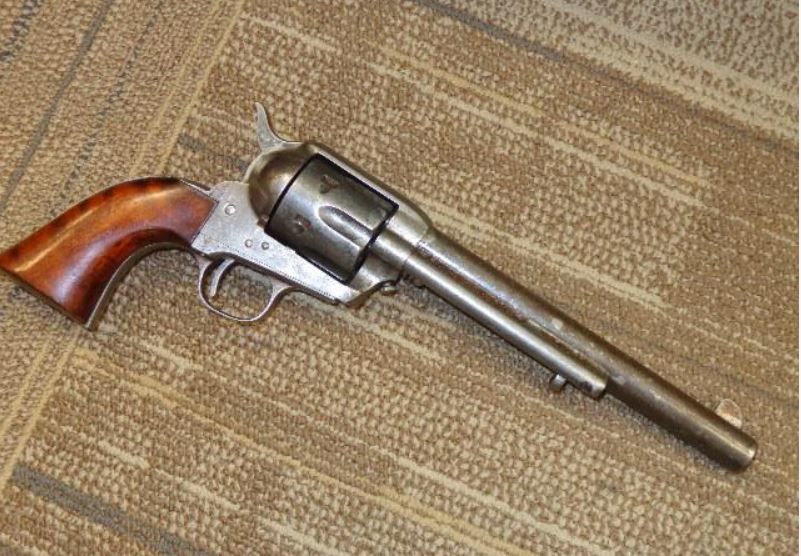
When introduced at the 1998 ‘SHOT Show” they were quite a hot item!
Making a revolver look like a 150 year old antique or relic is sometimes called “antique finish,” or “patina,” or “distressed” finish. And runs a gamut from bare metal, to pitted, to being devoid of 98-99% of its finish, round edged, dented, and scratched.
Revolvers made by Pietta, and marketed through places like Cabela’s, under the name “Old West,” are more faded metal finishes with the issue of their having mint grip finishes and grips.
Revolvers made by Uberti, and marketed through Cimarron are known as “The Original” and have greater metal “distress.”
Pietta started out using a play book page from counterfeiters, that being taking finished guns and subjecting them to various chemicals. One can do this at home using boiling diluted bleach or vinegar relying on their acid content. Eventually, Pietta came upon a secretive oil that removes, fades, and otherwise damages modern factory to tank blue after a three to four hour soak. The gun is then dried, and slightly polished, leaving a very “natural’ looking ‘faded’ blue and color case hardening antique “original” looking effect.
But the net effect is off because the metal is finish distressed but the parts or gun does not have wear or rounded edges and is “crispy” new with just an old finish (and new grips) on a “new” gun.
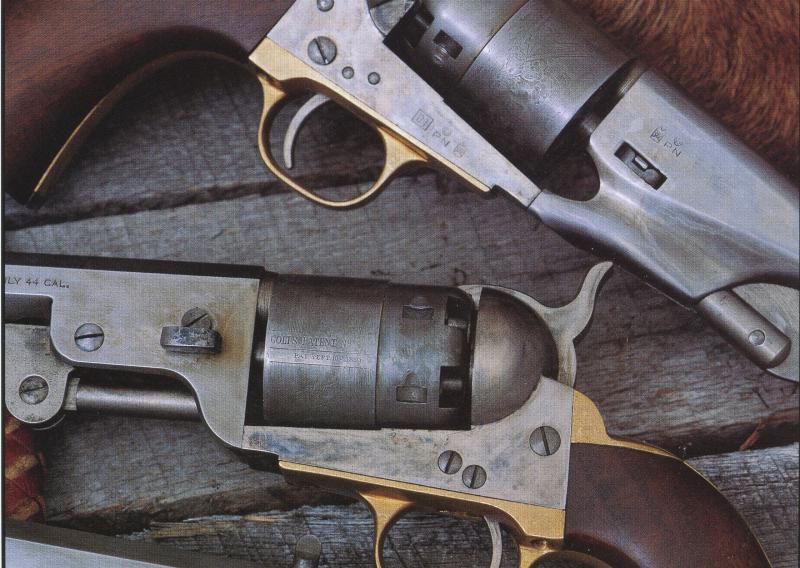
[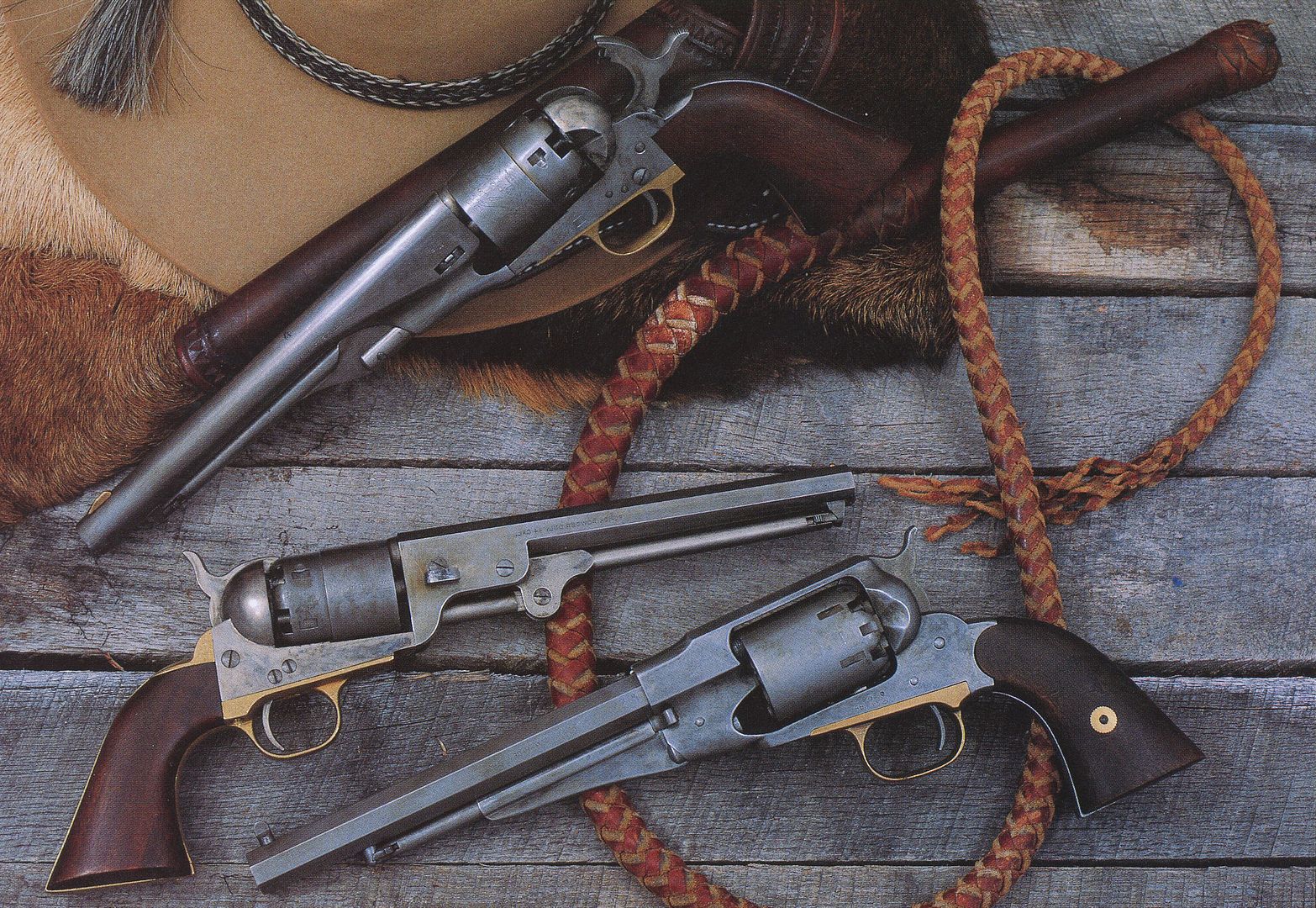
To get a much more aged, worn, and distressed look, Uberti went a different route also used by counterfeiters. Uberti places their unfinished and “in the white” gun parts in a tumbler (a similar concept to polishing rocks) with small rocks and bits of iron scraps. Towards the end of a tumbling cycle, the wooden grips are tossed in as well. When done being tumbled, the exposed outer metal parts are treated with acid to etch them to produce wear, slight corrosion, blemishes, discolorations, and pits. This is also a gun-by-gun process, so individual guns will vary on purpose making some more or less worse looking than others.
An original Colt M1860 in antique or relic condition:
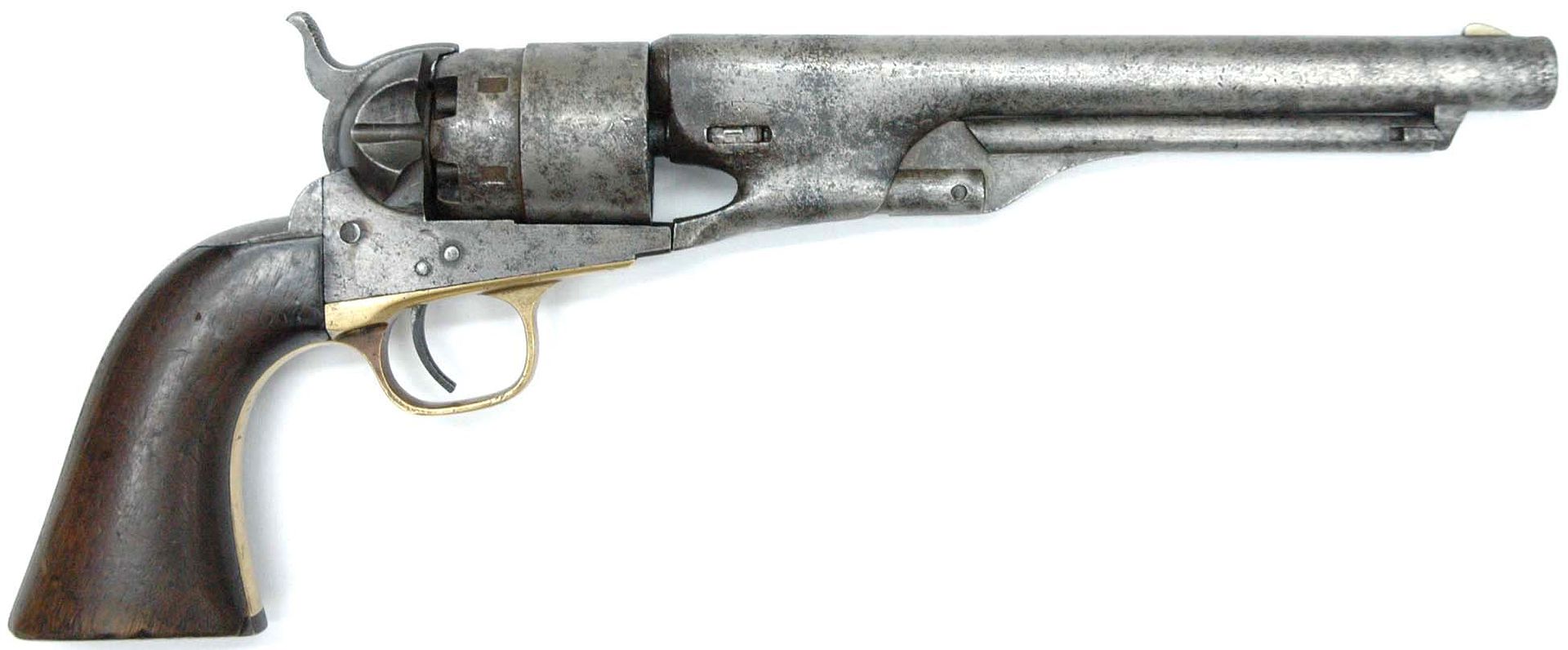
An Cimarron/Uberti "Original Finish" repro Colt M1860 Army:
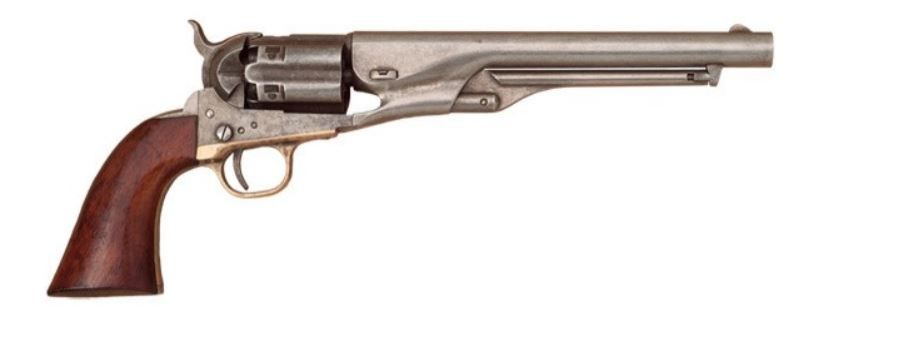
Implications…
One of the glaring holes or pits in our understanding of CW era weaponry lies with not knowing what the “life span” actually was for Period firearms. Meaning, in service, with use, and with Period cleaning and maintenance methods exactly how FAST or SLOW did a firearm lose its factory finish? Immediately followed by how ‘damaged” did a gun become when out in the rain or snow or hot sun every day?
In Reenacting and in Living History we tend to approach this topic or area of authenticity or Believable Image concerns by putting up with or ignoring the bogus modern Italian reproduction finishes to begin with, or we trust to a more “pristine” or “minty” look taking n some age, patina, wear by maintaining our reproduction firearms and letting the few days or weeks a year we have them in the field add character and some semblance of use. Especially so for lads who go the extra mile to (so-called) “de-farb” them (more a “musket” thing than a “revolver” thing, sadly).
Somewhere in the Middle, perhaps, lie the lads who try to exactingly replicate use and wear, such as holster wear or “fade” or “degrade” the typical, NUG, Italian finishes to appear more Period-looking and less Modern.
For example, the Italians use a modern hot tank form of blue, or blueing that produces a non-Period look of wet black ink. And their cyanide ‘color case hardening” is NUG dusty, gray, blue, and brown mottling thinly on the surface versus the look of a Period Colt’s.
Anyways, at the risk of using a Universal... no Civil War soldier used a 150 year old looking revolver, and they should have no place in serious Reenacting or Living History.
An original Griswold & Gunnison revolver.

An “original” finish reproduction:
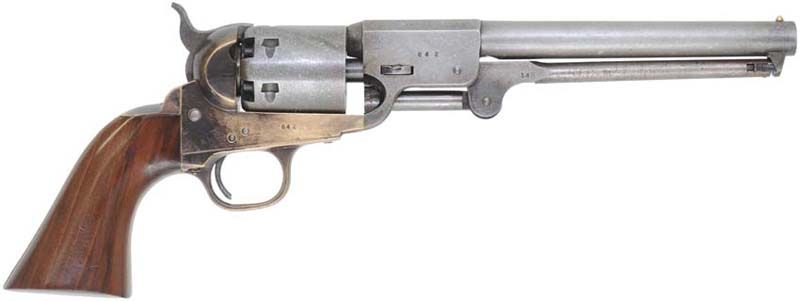
And last, although a later Colt Model 1871/72 "Open Top," this image reflects replicating both Period finishes as well as a (questimated/theorized) 5-10 year period of use.

Curt
No, not the finishes found on original revolvers leaving the factory.. but rather the antique or relic condition finishes found on original surviving Period firearms.
“Antique Finish. “The worst looking and most unauthentic and unhistorical guns one can buy.
In some segments of the reenacting and e3ven living history community, there used to be (and still is sometimes) the notion that using an original was the ultimate form of authenticity and historical correctness. Why? Because what can be more authentic and more Period Correct than to use the actual weapons used in the Civil War? Especially when the alternatives NUG fall to using Italian reproductions that while close simulations are not exacting copies or actual reproductions.
The flaw or farbery in that line of thinking is that yes, it would be true, if we all had the money to seek out and find original weapons in the condition they were when they were actually in use during the Civil War RATHER THAN 150 year old antiques or relics used, worn, battered, beat, faded, rusted, scratched, gouged, worm eaten, missing parts, sanded, polished bright, etc.
Instead, due to availability and particularly cost, what most lads do who use (unrestored) originals do, is to use a gun that is a century and a half too “relic condition” to have a believable image.
For the mounted service, this gets complicated by the availability of “antique finish” revolvers.
In Reenacting History, this generally grew out of lads building kits and lacking the access or ability to replicate color case hardening and blueing so they left things “in the white” or had revolvers so worn and beat that their finishes were shot and they wanted to make them more “original” looking. NOT as originals when in use, but as the antique, relic, and otherwise “distressed” look many older lads grew up watching in movies or in 1950’s or 1960’s TV shows before they arrival of Italian prop firearms that have largely replaced the old worn and beat bare metal originals used over and over and over until many believe that to be how firearms actually looked back then.
The history of antique finish revolvers can be traced back to the late 1990’s when Cimarron Firearms Company had an idea to appeal to original military and western leather collectors who were paying a thousand or two thousand dollars for a low-end original Colt or Remington to display in their gun belts rigs and holsters. The thinking was that a holster collector would be willing to pay instead, say $350 or $400 for a “holster stuffer” that looked “old timey” and appears to have been around since 1861.
The unforeseen aspect of Cimarron’s venture in getting “aged” Colts produced by Uberti was the phenomenal rise of Cowboy Action Shooting in the late 1990’s and early 2000’s.
Particularly, since the mean age of a CAS lad is in the mid 60’s with numbers of lad having a mental Picture or Vision of a “cowboy” guns set by their watching the original beat props in Hollywood “B” westerns and classic TV western shows.
A Cimarron/Uberti repro "Original Finish" Colt:

When introduced at the 1998 ‘SHOT Show” they were quite a hot item!
Making a revolver look like a 150 year old antique or relic is sometimes called “antique finish,” or “patina,” or “distressed” finish. And runs a gamut from bare metal, to pitted, to being devoid of 98-99% of its finish, round edged, dented, and scratched.
Revolvers made by Pietta, and marketed through places like Cabela’s, under the name “Old West,” are more faded metal finishes with the issue of their having mint grip finishes and grips.
Revolvers made by Uberti, and marketed through Cimarron are known as “The Original” and have greater metal “distress.”
Pietta started out using a play book page from counterfeiters, that being taking finished guns and subjecting them to various chemicals. One can do this at home using boiling diluted bleach or vinegar relying on their acid content. Eventually, Pietta came upon a secretive oil that removes, fades, and otherwise damages modern factory to tank blue after a three to four hour soak. The gun is then dried, and slightly polished, leaving a very “natural’ looking ‘faded’ blue and color case hardening antique “original” looking effect.
But the net effect is off because the metal is finish distressed but the parts or gun does not have wear or rounded edges and is “crispy” new with just an old finish (and new grips) on a “new” gun.

[

To get a much more aged, worn, and distressed look, Uberti went a different route also used by counterfeiters. Uberti places their unfinished and “in the white” gun parts in a tumbler (a similar concept to polishing rocks) with small rocks and bits of iron scraps. Towards the end of a tumbling cycle, the wooden grips are tossed in as well. When done being tumbled, the exposed outer metal parts are treated with acid to etch them to produce wear, slight corrosion, blemishes, discolorations, and pits. This is also a gun-by-gun process, so individual guns will vary on purpose making some more or less worse looking than others.
An original Colt M1860 in antique or relic condition:

An Cimarron/Uberti "Original Finish" repro Colt M1860 Army:

Implications…
One of the glaring holes or pits in our understanding of CW era weaponry lies with not knowing what the “life span” actually was for Period firearms. Meaning, in service, with use, and with Period cleaning and maintenance methods exactly how FAST or SLOW did a firearm lose its factory finish? Immediately followed by how ‘damaged” did a gun become when out in the rain or snow or hot sun every day?
In Reenacting and in Living History we tend to approach this topic or area of authenticity or Believable Image concerns by putting up with or ignoring the bogus modern Italian reproduction finishes to begin with, or we trust to a more “pristine” or “minty” look taking n some age, patina, wear by maintaining our reproduction firearms and letting the few days or weeks a year we have them in the field add character and some semblance of use. Especially so for lads who go the extra mile to (so-called) “de-farb” them (more a “musket” thing than a “revolver” thing, sadly).
Somewhere in the Middle, perhaps, lie the lads who try to exactingly replicate use and wear, such as holster wear or “fade” or “degrade” the typical, NUG, Italian finishes to appear more Period-looking and less Modern.
For example, the Italians use a modern hot tank form of blue, or blueing that produces a non-Period look of wet black ink. And their cyanide ‘color case hardening” is NUG dusty, gray, blue, and brown mottling thinly on the surface versus the look of a Period Colt’s.
Anyways, at the risk of using a Universal... no Civil War soldier used a 150 year old looking revolver, and they should have no place in serious Reenacting or Living History.
An original Griswold & Gunnison revolver.

An “original” finish reproduction:

And last, although a later Colt Model 1871/72 "Open Top," this image reflects replicating both Period finishes as well as a (questimated/theorized) 5-10 year period of use.

Curt





Comment